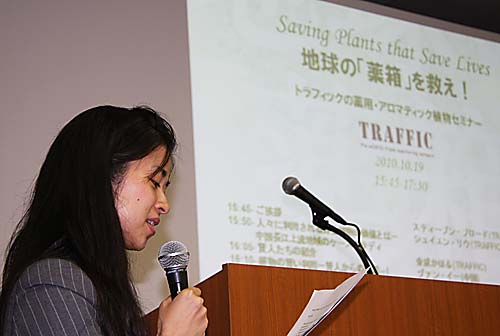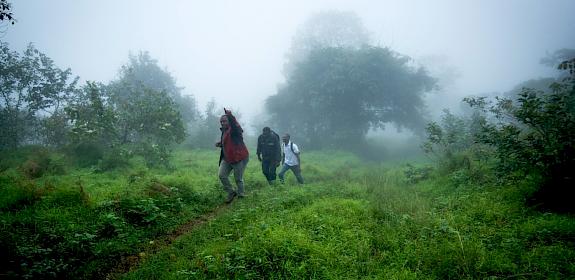Plants in focus during first week of CBD-CoP 10
Nagoya, Japan, 22nd October 2010—Amidst a complicated and cloudy week of negotiations this week at the 10th Conference of the Parties to the Convention on Biological Diversity (CBD – CoP 10), some Japanese autumn sunshine has fallen on some important discussions about the topic of wild plant conservation.

Yesterday, the Global Strategy for Plant Conservation (GSPC) was on the CBD’s agenda. Hopefully setting a positive precedent for the forthcoming plenary meetings, representatives of more than seventy countries spoke in favour of the adoption of an updated Global Strategy for Plant Conservation, including ambitious targets for 2011–2020.
TRAFFIC’s Medicinal Plants Programme Leader, Anastasiya Timoshyna, intervening on behalf of TRAFFIC and WWF in the CBD’s Working Group 2 suggested the inclusion into the GSPC toolkit of two guidelines, namely the FairWild Standard (see www.fairwild.org) for socially and environmentally sustainable use of wild plant resources, and the Guidelines for legal and responsible sourcing of timber as established by the Global Forest and Trade Network (GFTN, see http://gftn.panda.org/).
She further stressed “TRAFFIC and WWF recommend the use of the FairWild and GFTN Guidelines including their sets of principles and criteria for governments, companies and other stakeholders to verify sustainable and ethical sourcing of plants from the wild.”
Also during the first week of CBD- CoP10, TRAFFIC organized three side-events to raise awareness among delegates, visitors and the media of the importance and value of wild medicinal and aromatic plant resources, and promote the uptake and application of the FairWild Standard. Local traditional medicine practitioners from three continents joined TRAFFIC to showcase the benefits of the sustainable use of wild medicinal and aromatic plants for the health systems and livelihoods of their indigenous and local communities, or for the respective pharmacopoeias of their countries.
The side-events were kindly supported by the Keidanren Nature Conservation Fund and included a study on the economic aspects of harvesting and trading two medicinal species, the Chinese Caterpillar Fungus Cordyceps sinensis and Southern Schisandra Schisandra sphenanthera in China’s Upper Yangtze Ecoregion, presented by TRAFFIC’s Xueyan Liu (leaflet with more information on this project, PDF, 300 KB).
Talks by the traditional practitioners were made by Tashka Yawanawa, Chief of the Yawanawa indigenous people from Acre state in Brazil and Andrew Nainene Lelekoitien, Leader of the indigenous Yiaku tribe of the Mukogodo Forest in Central Kenya, both speaking about the medicinal plant contributions to local livelihoods and health applications in rural areas in Brazil and Kenya, respectively.
Prof. Zhang Yi, Deputy Director of the Academy of Chinese Traditional Medicine in Sichuan, China, spoke about the traditional knowledge associated with locating, harvesting and processing of plants. Finally, a presentation by TRAFFIC, linked these local examples to the global issues of wild plant conservation and the agenda of the CBD.
TRAFFIC went on to introduce the FairWild Standard as tool with great potential to help governments, communities and the private sector to ensure sustainable and equitable harvesting of and trade in wild plant resources.
Earlier this week, TRAFFIC launched two reports at the CBD into the global trade in agarwood, a product whose source trees, Aquilaria spp., in Asia are threatened by over-harvesting to supply the high demand for the product in the Middle East, Japan and Taiwan.
Deliberations at CBD-CoP10 continue over the next week.
Notes:
The Convention on Biological Diversity (CBD) is the major international agreement that supports the development of effective biodiversity conservation frameworks, the fair and equitable sharing of the benefits derived from wild natural resources and promotes international understanding of the value and importance of wild resources conservation.




